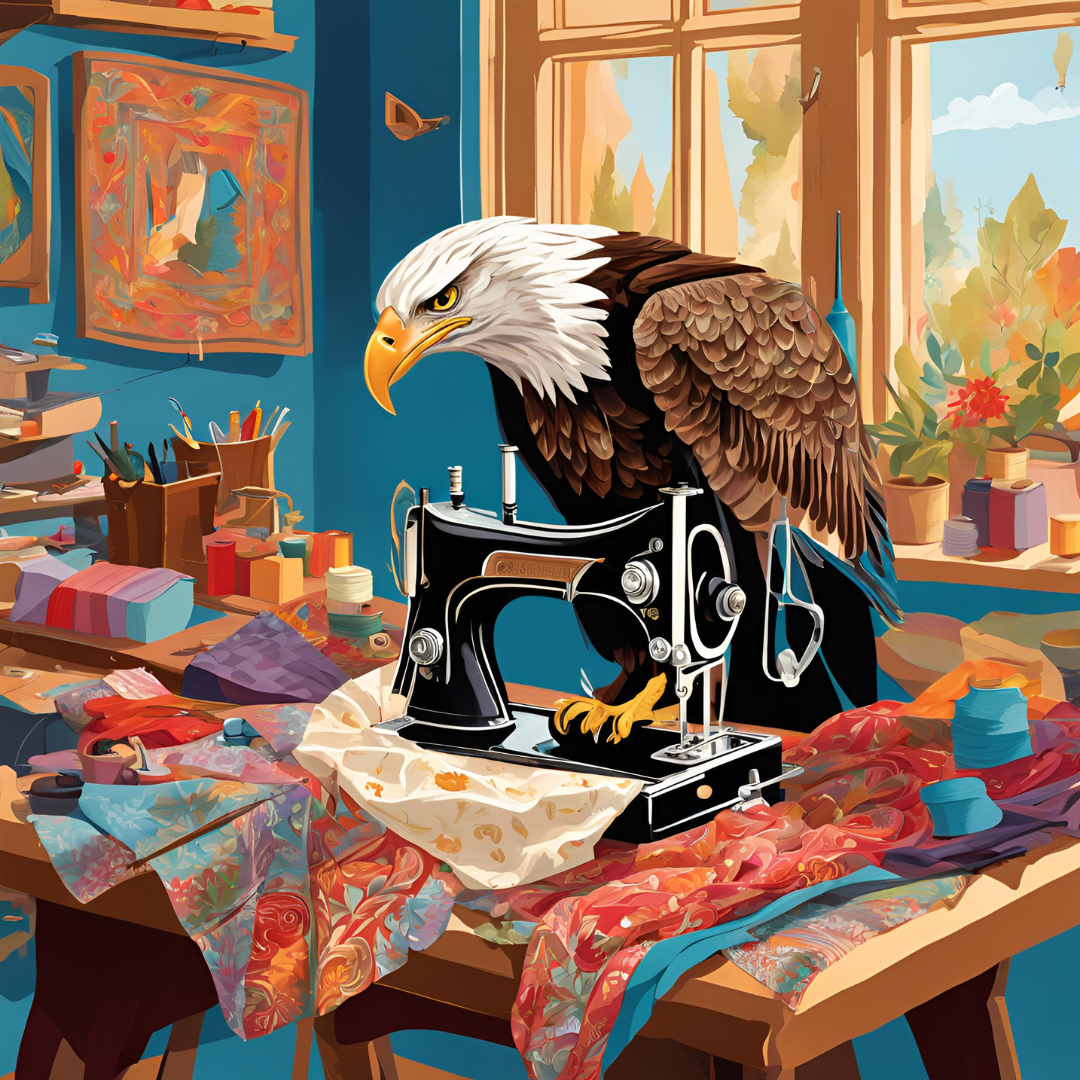
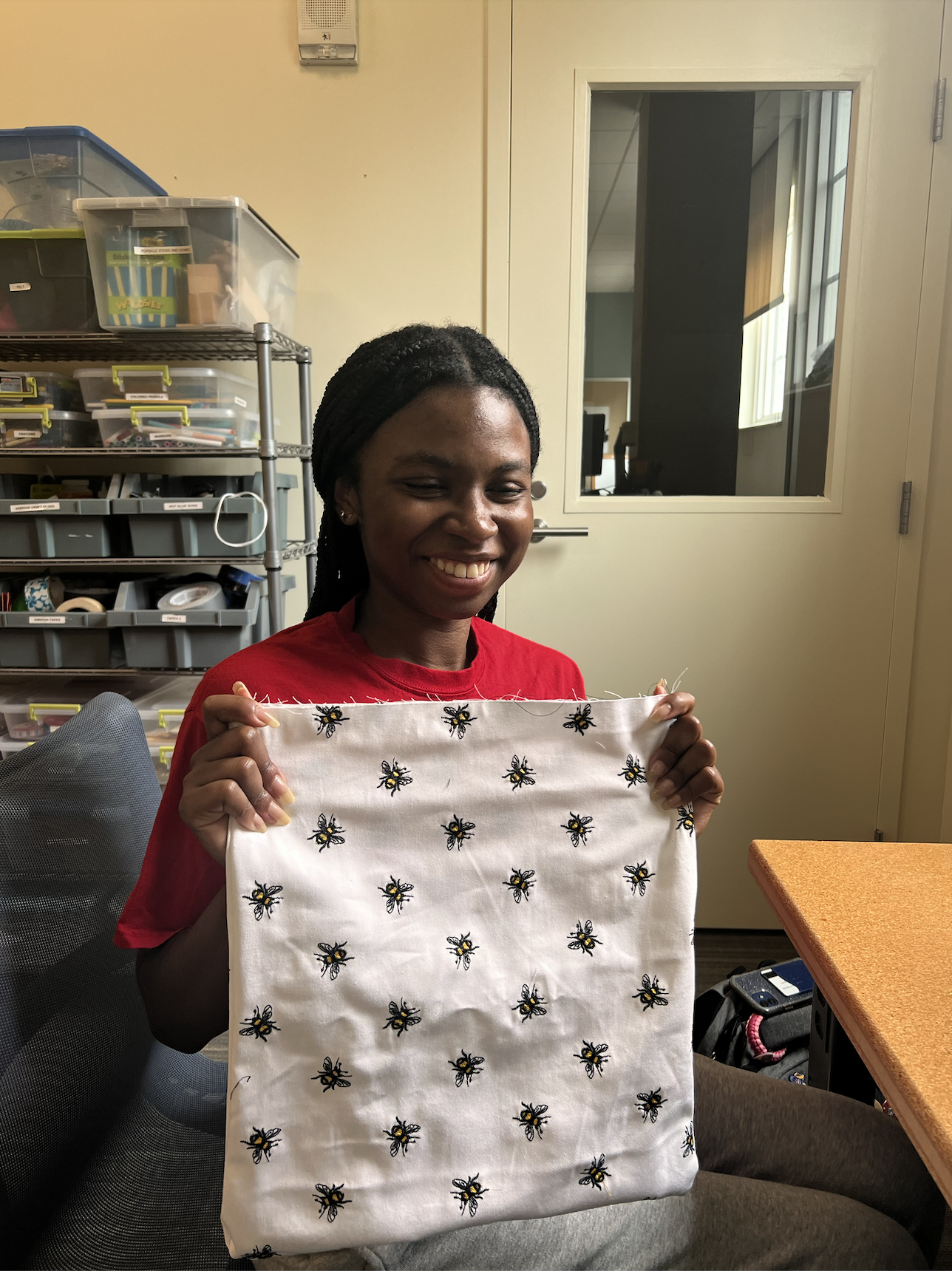
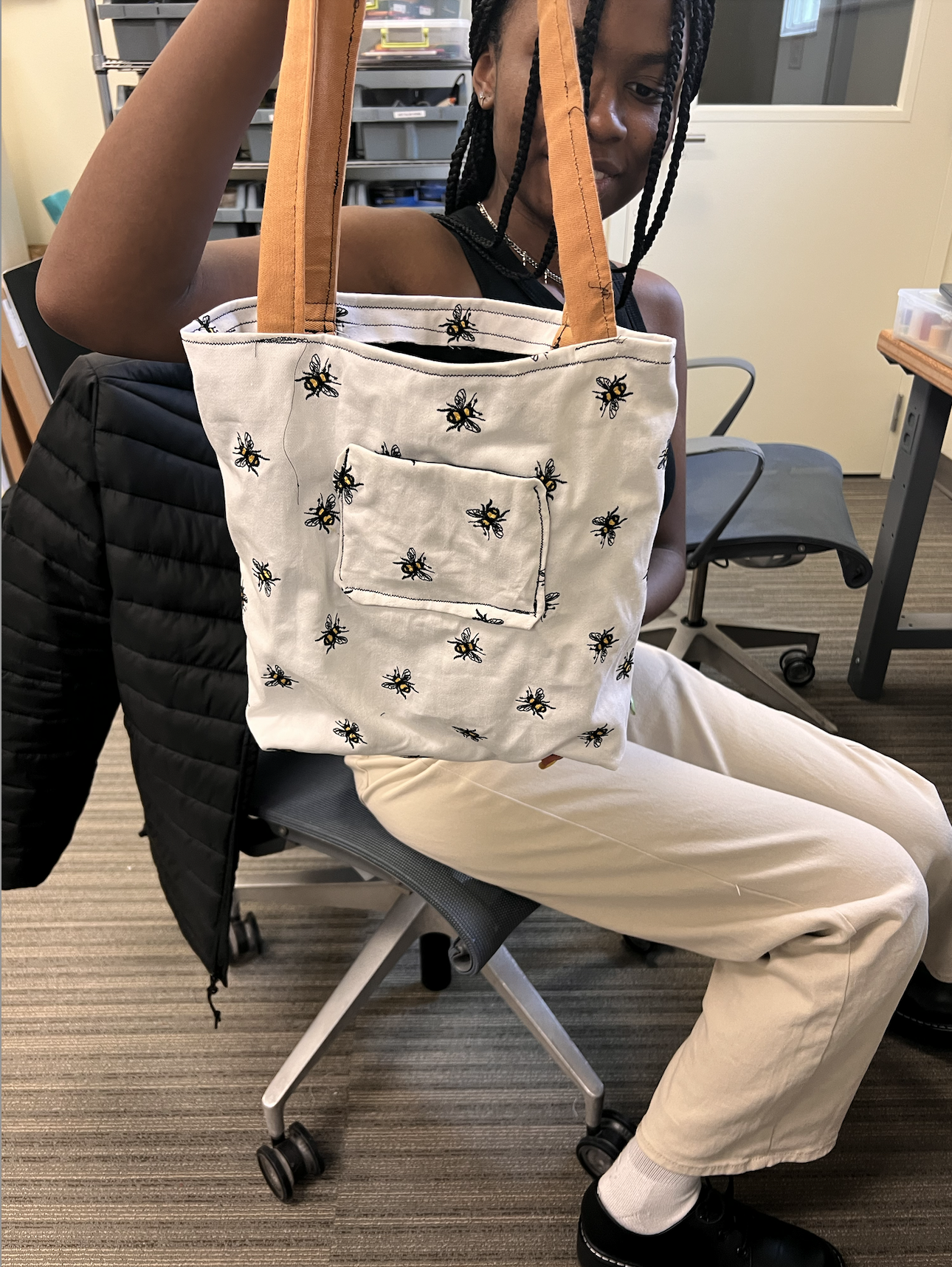
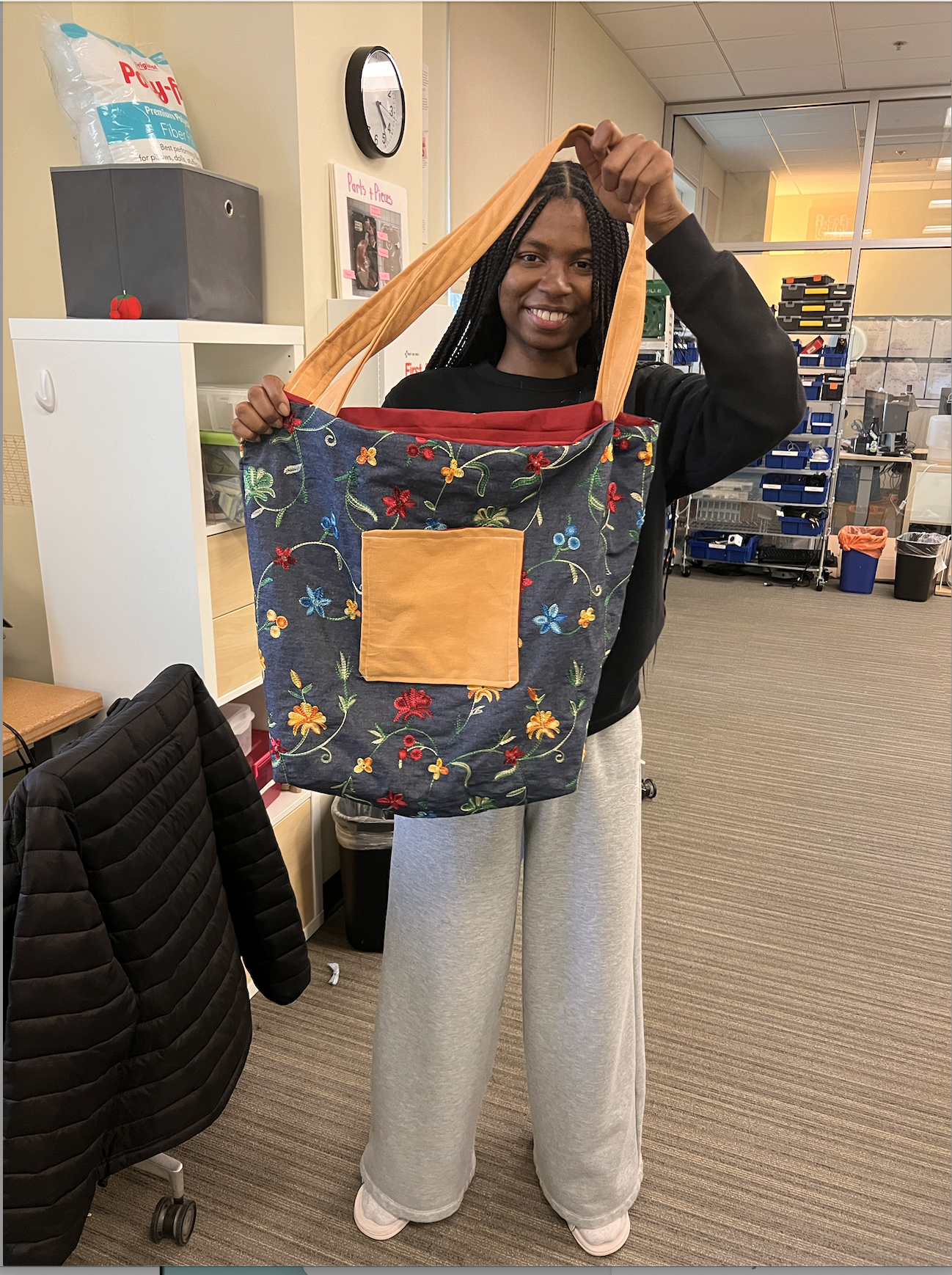
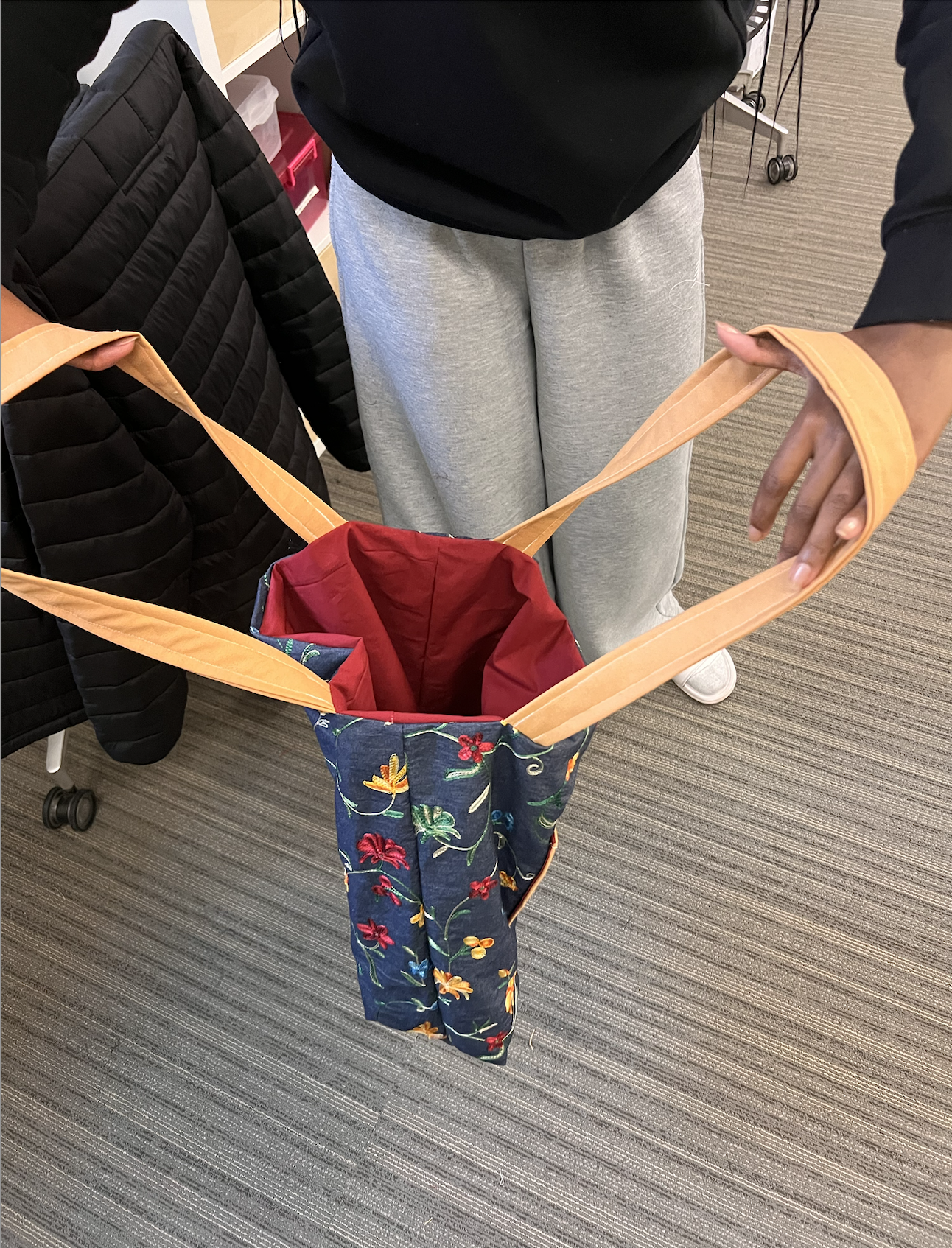
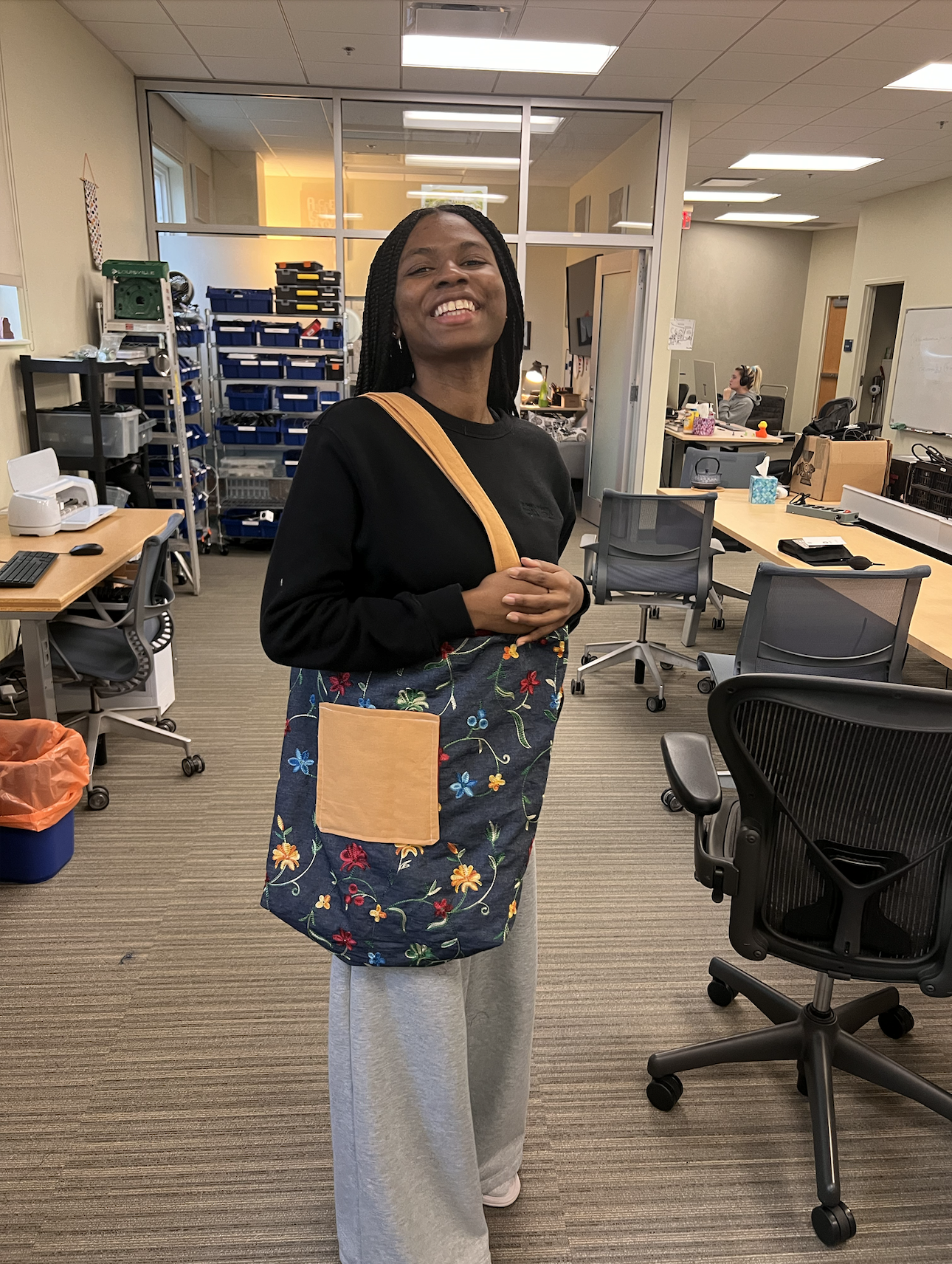
Transcript
Ally: Welcome to the Digital Creator Podcast, the show where we Spotlight students working on cool digital projects. I’m Ally, a consultant at the Digital Knowledge Center, where we empower students to be digital creators. Today’s guest learned how to use the sewing machines in the DKC, crafted 2 unique tote bags, and proved she could do it herself.
Ashley: Hi, I’m Ashley. I use choose letter pronouns and I’m a sophomore and my major is history and I’m trying to get a license to teach secondary education.
Ally: Awesome. So cool. So how did you come up with the project that you’re doing? Can you describe it a little bit and then what made you come to the DKC to do it?
Ashley: The main reason I even wanted to make a bag was because I had a coworker who came in with a bag that looked really nice and I thought,” wow, where’d you get that?” And I asked her and she was like,” oh, I made it.” And I was like, really, she’s like, yeah, I was switching at home, and I was like, how did you know how to make this? She’s like, “oh, I just used this video from TikTok.” And I was like. “Ohh OK can you send it to me?” So once I watched the video and I looked at all the stuff that you needed, I was like ohh. I could make this. I’ll just get some stuff from the store and then I’ll try to go to. I had to find somewhere with a sewing machine, but I had an idea that the DKC had one because of a presentation they did. I can’t remember when. But I was guessing they had one, so I just emailed to ask about it cause I didn’t see appointments. And they’re like, yeah, we have one and we have someone to help you figure out how to use it if you want to learn. I was like, oh, that’s great. So, then I went and got the stuff and made my first appointment.
Ally: Yeah. So, you’ve made two tote bags with us here at the DKC. And can you just tell us a little bit about like what was different between each bag and kind of like the process of learning how to sew, how that went for you? And just like a little bit more about that?
Ashley: A very big difference between the two bags is how it ended, because in the first bag we were doing really good throughout and then we got to the part where. We had to, we had to flip the bag back. Through after sewing straps on and. Something went wrong and. We had, we had to do. A fix to make it better, but it still looks fine. I love the bag. It has a Bee print. I’m never going to hate that bag.
Ally: Yeah, it was so fun. The Bee print is so cute. So, when you came in for the second bag. We kind of went like off pattern a little bit. Can you tell us about like? When you came in and you wanted to make it bigger and like add the buttons to it, was that because of like your experience with the previous bag or was it something that you always knew you wanted to do?
Ashley: I mainly I the only reason I really tried to make it bigger and with buttons is because I was thinking of what I loved and disliked about my original bag. Like there is obviously the big thing that went wrong with it, but I also didn’t love how small it was, cause I feel like it it can hold a lot. It can hold a lot, but I like wanted it. To. Hold more for some reason and I really wanted a way to close the bag because my original bag, it just kind of stays open unless you like have your arm right over it. So, it kind of closes with your own. Force. So I really wanted a way to close the bag and that’s why I did the buttons. And I also just really wanted to make another pattern bag because. And the bee print was really nice and I was like, I could probably find another print. That’s like, really nice. And I found this lovely little, like, flowery kind of print with denim. And I was like, yes, this is going to work perfectly.
Ally: Yes. Yeah, you have a good, you have good taste in choosing fabrics for these bags. I always am so impressed. Because then also you pick other fabrics that like complement them super well. I will say I am partial to the denim one. I thought that was so cute. So, so you told us that? You were inspired to make this specific to a bag because a coworker walked in with a bag. Had you thought about sewing beforehand, or was this your first? Sort of like, oh, why don’t I try to make that moment?
Ashley: I’m going to be honest. I have sewn before, I just haven’t used a machine back in middle school. I was in this class for all three years that was called FACS, Family and Consumer Sciences. Which is basically just home ec. So we got to do cooking, which was really fun, but we also got to do sewing stuff and I thought that was really interesting. Then it’s just I didn’t really have a way to expand on that in middle school, not like most of my family really had a sewing machine or. Well, my grandma, she had, like, a little sewing kit, but there was just like a needle and thread. And I have used it before to like fix holes in my clothing. But. Other than that, I didn’t really have access to a sewing machine. I didn’t know how to get one other than paying for it and I wasn’t about to do that.
Ally: Right, right. Well, that’s a good thing about the DC having publicly available sewing machines is that if you want to just, like, try it out, if you only handsewn before we have materials for both hand sewing and machine sewing. So that’s super cool. So, we we. Had a couple. Rough patches over the course of making these bags? Nothing. Nothing that was unfixable. But can you remember like a specific challenge maybe like other than the lining at the end of the first one that you just like we like we had to just. Come back to it. At a different time. (laughing) I I know there was a few, so just whichever one comes to mind, right away.
Ashley: I know I’m trying to. OK. Well, I guess for the newer one. It was going, I think the buttons was like a different thing to try to do because it was the first. Time. I was doing it and it was really fun. To get to do buttons but also. I quickly realized. I should have put these buttons on much earlier than when I did because it turned into me having to sewing buttons like through a tiny hole with barely any visibility, and then.
Ally: Yeah. For the listeners, we sewed the buttons to the lining of the second tote bag, but we completely completed the tote bag, sewed the lining, flipped it inside out and then we were like. Oh no, we have to add buttons. How are we supposed to do this? So, we had to the the seam Ripper was our best friend for that moment, and then we were able to come back in and do the buttons and then for that we also had to learn a whole new skill of using the like the button attachment on the machine. Do you want to talk about that a little bit?
Ashley: Yeah, that was really interesting. I thought I would absolutely hate it, but I actually, really. It’s really simple, I found it really simple when Ally explained it cause like it’s just like this little attachment that you add on when you take off the one that’s for sewing specifically, it’s just this one. Gives a little like circle area where you have to end up cutting the little hole that the button will go through, but it keeps it stable, so it’s not just constantly ripping. That part is actually pretty easy if you know the sizing you want, then it’s like a really simple process, like. It doesn’t take very long. It’s just if it’s your first time doing buns, I would say that it might be more because you constantly have to keep going back through over and over again so that it becomes a strong hold on the button and it’s not super loose and could possibly break later.
Ally: Yeah, yeah, definitely. Utility was like, yeah, in the forefront of our minds for that. And I think also something that was really good that we did was we did multiple practice buttons on like scrap fabric. Did you find that helpful to do?
Ashley: That was super helpful because. Other if I hadn’t, I would have messed up my bag badly.
Ally: It was important for us to kind of figure out the length and like how long and wide the button hole needed to be to like fit the buttons that we had. So that’s always good. I think that it’s always good to do like a test or like a practice version of something before you sew the final thing. Even though there is like a lot of forgiveness in sewing, there are some things where it’s just like now I have to rip an entire section out and you want to avoid that as much as possible. So I think I think that that. Was good and I was. Always grateful when I was like, what if we? Did. A scrap piece and you were like, OK, instead of wanting to go straight into it, I feel like that was probably a good deal for. Yes. So I know that like. Especially for me, getting back into sewing for the DKC, I’ve started to like, notice things about sewing in other places, seen things that I want to recreate, stuff like that. Have you had those experiences where, like you see other things and it makes you think? Of sewing at all.
Ashley: Um I think? I’ve. My brain. I have thought of clothing because of you. Alley. I like you making that whole piece. I was like ohh, that is really. That’s like really good. And the fact that you’re doing it, I’m just scared to make clothing cause I feel like I’ll mess it up somewhere in the measurements. But other than that, I would probably say. Making like like stuffed animals, things like that. I’ve thought about that. That sounds like a another great start to somewhere or like something I can use like a blanket? I don’t know, but clothing is a thought for the future though I don’t know.
Ally: Well, I’m trying to convince Ashley for our next project to make a Bunny, make a Bunny stuffed animal. And the good thing about stuffed animals is that you can make clothes for them, and then that’s basically like making clothes for a person, but smaller. So, you get the practice in and then you can make it for yourself. So, stay tuned. Maybe we’ll have another episode about our Bunny. What’s something that you’ve learned during the process? It doesn’t necessarily have to be about sewing itself, but like. Just anything that you feel like this experience has taught you, and I’ll let you decide if you want to go like broad or specific with that.
Ashley: I would say if you’re learning how to sew. Be ready to just have a lot of time with you, just on one specific section or just working really long on something and it might. The machine might do something to you, and you’re just angry with it, which you have to work with it and just keep going. A great example would be when we did straps. The first project when we did straps, in particular those straps would be so annoying because. The sewing machine would always do something and it. Would.
Ally: Yeah, it would like jam. It would jam and then the the strings on like the back of the straps cause the straps we didn’t like, flip inside out at all. And so the thread that you saw was like the thread that you would see on the final project and we just kept getting all these kinds of loops and stuff and that didn’t end up happening on the second project as much really it might have been because we switched machines.
Ashley: That probably is, yeah.
Ally: But yeah, I feel like the technological aspect. Of like of the actual sewing machine can really be a roadblock sometimes with certain projects just because sometimes it doesn’t want to cooperate. And sometimes your bobbin winds, weird and sometimes something’s wrong and you don’t know why it’s wrong and you have to just kind of work with it and start over. And yeah, I actually the other day we were in a class visit and somebody asked a question and they said, how do sewing machines? Fit in with digital knowledge like why are there sewing machines in the Digital Knowledge Center? And I was like, let me answer that. And one of the things I said is that like it prepares you for other like digital projects specifically, I brought up like pattern making, which we’re not there yet, we could be. But I brought that up and I also said that a lot of sewing machines nowadays, not the ones that we have here in the DKC, but a lot of them, like, have digital aspects where instead of having like a knob to turn for stitch types, it’s all digital. Like it’s on a screen. And so, I think that that’s super interesting and I feel like any kind of knowledge you have of a physical machine and how that works like translates to other things. Do you agree?
Ashley: Yeah, I agree. I agree.
Ally: Yeah. And I’ve noticed too, like with our 3D printers that we have here the. The plastic that we use for those is set up very similarly to a bobbin for a sewing machine, and that you have to kind of like it’s wound on like a spool. And then you have to kind of like thread it almost through the mechanism and the 3D printer, so that’s super interesting for me to see and like hopefully as you like, go on in your digital knowledge journey, you’ll like start to like pick things up on that. Like I’ll see things on TV and I’ll be like, ohh or like I’ll see something in a store and I’m like ohh I know how they did that. So I think that’s super cool. And I think that also comes with like the more you make things, the more you learn about them. Yeah, yeah. So what has been the most rewarding thing for you with making these bags? Is it, like physically having a tote bag? Is it learning the skill? Is it something else?
Ashley: I I for one. Yeah, I definitely agree with learning a skill because that’s. It’s something interesting. It’s something fun that you could figure out because it’s this is like the like, like your parents say, like all the time. Like, college is only one time of your life. You better enjoy it while you can. And I’m like, OK, I’ll learn this now. While there’s a free like sewing machine to use. That includes what I already am here for and I can see if I would want to continue this sort of hobby in the future or do something else with it. Because I’ve gotten to show off my little bags to like my family, and they’re always like, I think the first few people I showed. It to they’re like, “That’s a like. That’s a nice bag.” They thinking it in their heads. But like my parents will say. Ohh yeah, she made it and they’ll be like what? I thought she just got it from a store and I’m like ohh. That’s so nice. I love that.
Ally: Professional quality.
Ashley: Like that is amazing. I didn’t know it looked. It looked that neat. It was like because when you’re making something, I will say you don’t. You will only really notice the things that went like wrong on it. So you won’t think about how it might look to someone who didn’t make it. Like, yeah, for my first bag, my brain always thinks of that weird part that went wrong at the end. And then like the straps. And I’m like the Dang straps. The straps are a nightmare, but like. If you look at it without that knowledge, you’re like, oh, this is a nice bag. It looks really nice. You have bees on it, you have little flowery vines on it. It’s like a nice bag…what’s the question?
Ally: The most rewarding thing I think, yeah, I think you got there. I’m. I’m here for it. But yeah, I think. I think also the nice thing about sewing is that it’s such a practical skill. That like now you’ve had experience with both like hand sewing and machine sewing. And with this last project sewing buttons, I mean, how many times you have a button pop off and like now you can just get a new button and sew it on, you know or like use the buttons that they send with you sometimes. Sometimes you get clothes and they give you an extra button and that’s why. And now you know how to do that. So yeah, I think I think it’s super cool also. It’s so cool that your family is like you made that I love that reaction. Like that’s that’s such a great response to saying that you made something as being like “whaaaat?”
Ashley: It’s really nice. It’s like a great feeling.
Ally: Yeah. So do you have any plans for projects going forward with sewing?
Ashley: I am trying to figure that out at the moment because I’m trying to figure out what I want to do. I already you have discussed with me the Bunny.
Ally: Yes, I’m very pro Bunny.
Ashley: I’m I’m thinking about it. I’m thinking I just have to figure out. When I would start. Also I wanted to try to do stuff in the summer, but I don’t know about that yet. If it will be available in the summer completely, I know you kind of said
Ally: yeah, I’m not 100% sure how that works. I don’t know if our actual space is open OK, but I can. I’ll check for you.
Ashley: OK, I’ll try to. I’m trying to just. I’m trying to figure out something before. Or. We’re like too far in to, like, close to the end of that semester. But I think if I do do something next, it would be some sort of stuffed creature because I already have two bags I need to start branching out.
Ally: You need some stuff to put in it. You need some stuff to put in the bags. That’s what I’m talking about.
Ashley: Yes.
Ally: All right, that is everything I have for you. Do you have anything you’d want to shout out or just anything you want to add before we kind of finish up here?
Ashley: UM. I would say. If you’re looking to start sewing Joann fabrics, it’s a lovely place to go. I went to Michaels first, but they don’t really have stuff for sewing, so I was like, ohh and I went to my and I went to Joann’s. I was like oh, this is like this is this is made made for the people that are like making things with fabric, so yes.
Ally: We love Joann’s.
Ashley: Hit up Joann’s first always. Always try there.
Ally: All right. Last question I have for you, would you recommend that someone comes in and does a sewing project at the Digital Olive Center with me or another consultant?
Ashley: Oh well. Definitely. I would so love people to come in because it people aren’t coming in as much. People more are coming in this semester, but like last semester. Not a lot of people came into the sewing machine, but it’s like so much fun.
Ally: Thank you so much, Ashley and I look forward to more projects with you. This has been the digital Creator podcast. You can find a transcript of our conversation and more about this project. Below his podcast was produced and edited by Me, Ally Hamilton, with help from the resources of the Digital Knowledge Center. Are you interested in becoming a digital creator? Do you have a cool project you want to share? Go to dkc.umw.edu for information on how to get started. Thank you for listening!
For information on how to apply for a fellowship visit the DKC site.
You can make your own version using Neoma Accessories Tutorial!
Reply